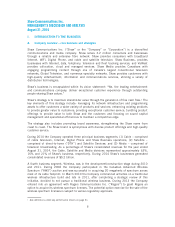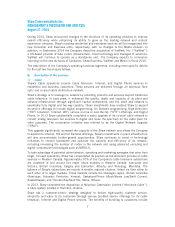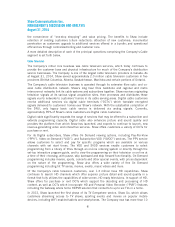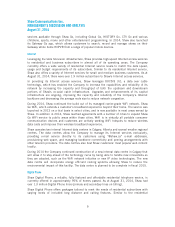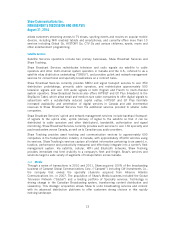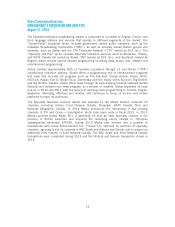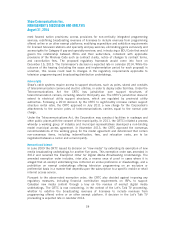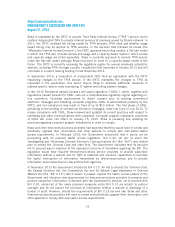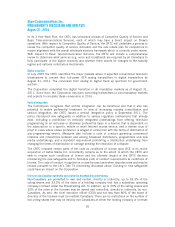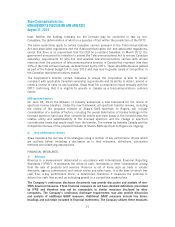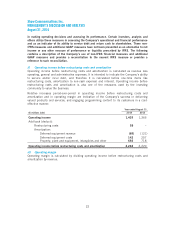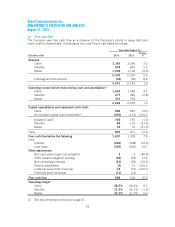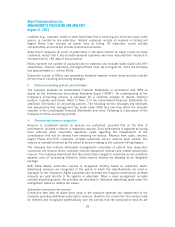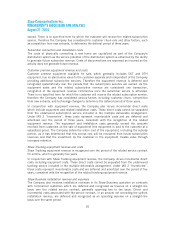Shaw 2014 Annual Report Download - page 20
Download and view the complete annual report
Please find page 20 of the 2014 Shaw annual report below. You can navigate through the pages in the report by either clicking on the pages listed below, or by using the keyword search tool below to find specific information within the annual report.Shaw Communications Inc.
MANAGEMENT’S DISCUSSION AND ANALYSIS
August 31, 2014
Under the Telecommunications Act, the CRTC is responsible for ensuring that Canadians in all
regions of Canada have access to reliable and affordable telecommunication services of high-
quality. The CRTC has the authority to forbear from regulating certain services or classes of
services provided by a carrier if the CRTC finds that there is sufficient competition for that
service to protect the interests of users. All of Shaw’s telecommunication retail services have
been forborne from regulation and are not subject to price regulation. However, regulations do
impact certain terms and conditions under which these services are provided. On October 23,
2014, the Government tabled Bill C-43 which amends the Telecommunications Act to grant the
CRTC powers to impose administrative monetary penalties of up to $10 million for each
contravention of the Telecommunications Act or any regulation or CRTC decision pursuant to
the Telecommunications Act, and up to $15 million for each subsequent contravention.
The technical operating aspects of the Corporation’s businesses are also regulated by technical
requirements and performance standards established by Industry Canada, primarily under the
Telecommunications Act and the Radiocommunication Act.
Pursuant to the Copyright Act, the Copyright Board of Canada oversees the collective
administration of copyright royalties in Canada, including the review and approval of copyright
tariff royalties payable to copyright collectives by BDUs, television broadcasters and online
content services.
The sections below include a more detailed discussion of various regulatory matters and recent
developments specific to Shaw’s businesses.
Licensing and ownership
For each of its cable, DTH and SRDU undertakings, the Corporation holds a separate
broadcasting license or is exempt from licensing. In November 2010, the majority of cable
undertakings owned and operated by the Corporation were renewed by the CRTC for a five-year
period ending August 31, 2015. Shaw’s cable licenses for its undertakings serving British
Columbia, Alberta, Saskatchewan and Manitoba are scheduled for renewal in 2015. The
licenses of the Corporation’s DTH and SRDU undertakings were renewed in 2013 by the CRTC
for a seven year period ending August 31, 2019. Shaw has never failed to obtain a license
renewal for its cable, DTH or SRDU undertakings.
The Company also holds a separate license for each of its conventional OTA television stations
and each specialty service. These CRTC broadcasting licenses must be renewed from time to
time and cannot be transferred without regulatory approval. The majority of the Corporation’s
licenses for its OTA television stations and specialty services were renewed for a five-year term
ending August 31, 2016. The renewal decision implemented an expenditure-based regulatory
regime, whereby the Corporation must expend a certain percentage of its prior-year revenues
from its conventional OTA and specialty services on Canadian content, and also on specific
categories of Canadian programs defined as “programs of national interest”. These obligations
are imposed on an individual license basis. With certain restrictions, the Corporation may share
these regulatory obligations between and among its various conventional OTA and specialty
licenses.
The potential for new or increased fees through regulation
Effective September 1, 2009, each licensed BDU was required to contribute 1.5% of its gross
revenues derived from broadcasting to the Local Programming Improvement Fund (“LPIF”) to
support local television stations operating in non-metropolitan markets. Exempt systems were
not required to contribute to the LPIF. In July 2012, the Commission determined that it was
16


